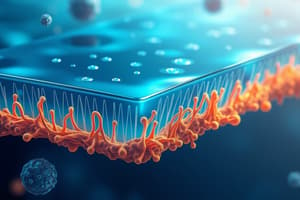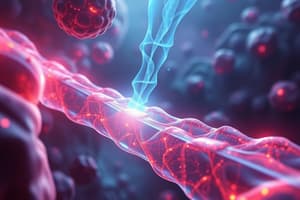Podcast
Questions and Answers
98% of the molecules in the plasma membrane are ______.
98% of the molecules in the plasma membrane are ______.
lipids
Various movements of the ____ keep the membrane fluid.
Various movements of the ____ keep the membrane fluid.
phospholipids
Dispersed throughout the membrane are _______ that may be transmembrane or peripheral.
Dispersed throughout the membrane are _______ that may be transmembrane or peripheral.
proteins
The membrane is stiffened in some spots, decreasing its fluidity, by _______ molecules.
The membrane is stiffened in some spots, decreasing its fluidity, by _______ molecules.
The ____________ surrounds the cell and is made of proteins and __________.
The ____________ surrounds the cell and is made of proteins and __________.
The composition of the plasma membrane can differ from one region of the ____________ to another.
The composition of the plasma membrane can differ from one region of the ____________ to another.
The material between the plasma membrane and the nucleus is called the __________.
The material between the plasma membrane and the nucleus is called the __________.
The cytoplasm consists of a fluid, called ____________, and several functional units of the cell, called ____________.
The cytoplasm consists of a fluid, called ____________, and several functional units of the cell, called ____________.
Click and drag each label into the correct category to indicate whether it pertains to the cytoplasm or the plasma membrane.
Click and drag each label into the correct category to indicate whether it pertains to the cytoplasm or the plasma membrane.
Determine from the description which cellular structure each phrase is describing.
Determine from the description which cellular structure each phrase is describing.
What are extensions of the plasma membrane that serve primarily to increase a cell's surface area called?
What are extensions of the plasma membrane that serve primarily to increase a cell's surface area called?
Click and drag each cellular component to the appropriate category based on whether or not it is bound by a membrane.
Click and drag each cellular component to the appropriate category based on whether or not it is bound by a membrane.
Which membrane-bound organelle is the site of protein and lipid synthesis?
Which membrane-bound organelle is the site of protein and lipid synthesis?
What is the function of the highlighted organelle?
What is the function of the highlighted organelle?
What is the function of the highlighted organelle?
What is the function of the highlighted organelle?
What is the function of the highlighted organelle?
What is the function of the highlighted organelle?
Lysosomes are membrane-bound vesicles that arise from the __________.
Lysosomes are membrane-bound vesicles that arise from the __________.
The lysosome contains ________ enzymes.
The lysosome contains ________ enzymes.
Lysosomes function in the destruction and recycling of old organelles.
Lysosomes function in the destruction and recycling of old organelles.
Flashcards are hidden until you start studying
Study Notes
Plasma Membrane Composition
- 98% of molecules in the plasma membrane are lipids, primarily phospholipids.
- Phospholipids allow various movements that maintain membrane fluidity.
- Proteins within the membrane can be transmembrane or peripheral.
Structural Components
- Cholesterol molecules stiffen certain areas of the membrane, reducing fluidity.
- The plasma membrane surrounds the cell and is composed of proteins and lipids.
- Plasma membrane composition can vary across different cell regions.
Cytoplasm Definition and Composition
- The cytoplasm is the material located between the plasma membrane and the nucleus.
- It consists of cytosol (the fluid component) and various organelles (functional units).
- Organelles include membrane-bound structures like mitochondria, lysosomes, and the endoplasmic reticulum.
Cell Membrane and Cytoplasm Functions
- The plasma membrane is crucial for containing ion channels and interacting with extracellular fluid (ECF).
- The cytoplasm comprises structures like the cytoskeleton, fibers, and organelles, which support and facilitate cellular functions.
Cellular Structures
- Microvilli are extensions of the plasma membrane that enhance surface area for absorption.
- Membrane-bound organelles include the nucleus, mitochondria, lysosomes, endoplasmic reticulum (ER), and Golgi complex.
- Non-membranous structures include ribosomes, centrosomes, centrioles, glycogen granules, and the cytoskeleton.
Organelles and Their Functions
- The endoplasmic reticulum is the site for protein and lipid synthesis.
- Organelles have specialized functions such as regulating transport and modifying proteins.
- Mitochondria are responsible for producing ATP through cellular respiration.
- Lysosomes, formed from the Golgi complex, contain hydrolytic enzymes for breaking down cellular components.
Lysosomes
- Lysosomes play a key role in destroying and recycling old organelles, maintaining cellular health.
Studying That Suits You
Use AI to generate personalized quizzes and flashcards to suit your learning preferences.




